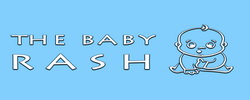How To Treat a Baby Rash?
As a parent, dealing with a baby rash can be frustrating and worrisome. You just want your little one to feel comfortable and happy. Have you ever felt confused about what causes those red spots on your baby’s skin? Or how to treat them? Our guide, “How to Treat Baby Rash,” is here to help. We understand the importance of finding a solution, and we’ll walk you through various types of rashes, how they appear, and the steps to take to get rid of them. Our guide is designed to be simple and straightforward, so you can focus on helping your baby feel better. Let’s explore the basics of baby rash solutions together and ensure your little one is feeling their best. Ever wondered why those red spots appear? Or what to do when they show up? This guide, “How to treat a baby rash?” has all the answers. We’ll talk about different rashes, what they look like, and how to make them disappear. No confusing stuff—just simple steps to help your baby feel better. Let’s dive into the ABCs of baby rash solutions!
The Normal Baby Rash or Newborn Baby Rash: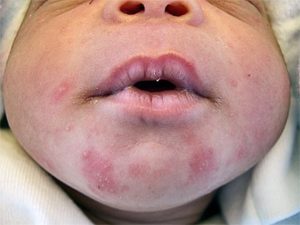
As the name suggests, it is very common and Normal for a baby to develop this type of rash. It is also known as Erythema toxicum neonatorum. This rash develops from a couple of hours after delivery to two weeks’ time. In some cases, it is reported to have appeared after a month and a half after birth. This type of rash resembles the rash near acne in adults, but please be careful not to confuse this rash with acne, and do not use any type of acne cure products on this rash.
The “normal baby rash” is believed to not cause any discomfort to your baby.
Baby Acne: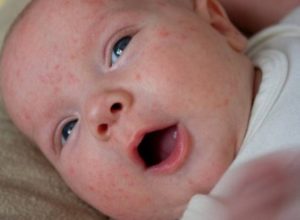
Baby Acne, sometimes referred to as Neonatal acne, appears after one month after birth. It resembles little pimples. Most of the time, this type of acne appears on the forehead and chin of the baby. They will vanish on their own, but sometimes they can get worse before disappearing completely.
Keeping your baby clean, washing him with a mild baby soap, and keeping him dry in a humid environment will help in the disappearance of Baby acne as soon as possible.
Nappy Rash or Diaper Rash:
One of the most common rashes in babies is the nappy rash or diaper rash. It occurs due to the use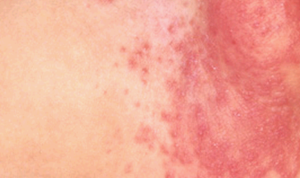 of a nappy or a diaper, what happens is that air from outside is blocked to reach the skin of the baby, and the baby sweats and remains humid in his own urine-soaked nappy or diaper causing this rash.
of a nappy or a diaper, what happens is that air from outside is blocked to reach the skin of the baby, and the baby sweats and remains humid in his own urine-soaked nappy or diaper causing this rash.
This kind of rash can sometimes be very irritating and may cause the skin to itch. You can moisturize the skin of your baby or put some diaper rash cream on the affected area and this rash will clear up quickly. To avoid this type of baby rash, change the diaper or nappy frequently and if possible leave your baby with a nappy or diaper for a couple of hours so that the baby can dry up and relax as well.
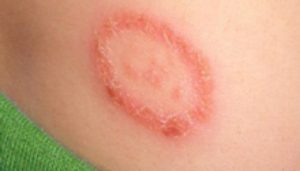
Ringworm:
If you see a red circle on the body of your baby. It may be ringworm. Ringworm is a fungal infection and can develop anywhere in the body of your baby. It can be treated by using creams available in your local pharmacy; normally the treatment for ringworms is available without a prescription. All you have to do is be careful to buy the ones meant for baby skin only.
Cradle Cap a kind of Baby Rash: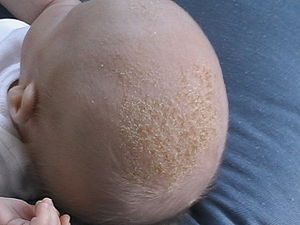
It is a greasy and yellowish type patch that will develop on the head and adjoining face area. It is mainly caused by an oily skin. This rash is not contagious and does not require special treatment. Softly brushing your baby’s hair and applying a mild hair lotion will make the Cradle cap go away. Always use baby shampoo to wash your baby’s hair.
Mouth, Hand and Foot Disease: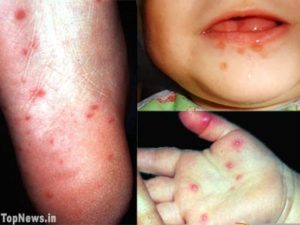
Unlike other baby skin rashes, Mouth, Hand and Foot Disease is viral. In this kind of rash, you should expect your baby to run a fever and feel uneasiness. The signs of this rash are that blister-like pimples will appear on the Hands, feet and even in the mouth of your baby. Baby’s immune system is enough to get rid of this kind of rash but still, if the fever gets higher or your baby’s rash worsens, do consult your pediatrician.
Sweat Rash (Prickly Heat):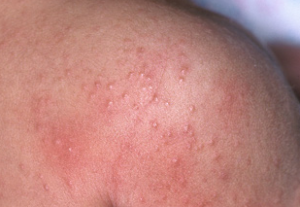
Another most common baby rash is the sweat rash. Sweat rash or Prickly heat occurs mostly in hot and humid environments. If your baby is covered and her sweat glands have blocked, this rash will develop. In this kind of rash, the skin of your baby becomes bumpy and reddish. Sweat Rash or Prickly Heat rash appears mostly in the underarms, rash on the neck, and a rash between the legs near the privates. So, when you notice a baby rash on the neck, it could be a sweet rash. The best way to get rid of sweat rash or prickly heat is to dry up the baby’s skin, wear her loose clothing, and you may use some baby prickly heat powder.
.
Hives:
If the rash on your baby appears to be red and the skin feels swollen, she might have hi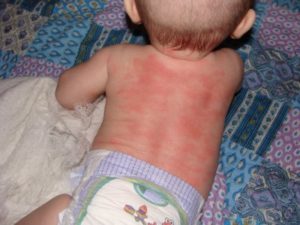 ves. Hives are normally caused by an allergic reaction to some food that the baby ate, or in the case of a breastfed baby, it may even be caused by the food that the mother took.
ves. Hives are normally caused by an allergic reaction to some food that the baby ate, or in the case of a breastfed baby, it may even be caused by the food that the mother took.
Just like other rashes, hives will also go away on its own. If hives appear more frequently, keep an eye on what the baby ate or you ate. The baby may be allergic to it, and if you cannot determine what is causing hives in your baby do consult your baby’s pediatrician to determine the cause of the allergy.
.
.
Impetigo Baby Rash:
Impetigo is a highly contagious rash and is mostly caused by direct contact of yo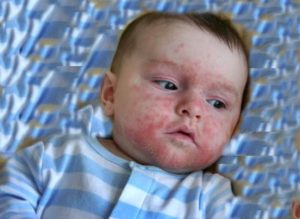 ur baby with someone who has impetigo. It also may appear after eczema. Your baby will have a yellowish scalp, and it is bumpy. In some cases, it may appear as if your baby has extremely dry skin. Impetigo causes sores and bristles in the skin. Impetigo starts around the nose, and face and may spread to the limbs.
ur baby with someone who has impetigo. It also may appear after eczema. Your baby will have a yellowish scalp, and it is bumpy. In some cases, it may appear as if your baby has extremely dry skin. Impetigo causes sores and bristles in the skin. Impetigo starts around the nose, and face and may spread to the limbs.
Impetigo is usually treated with antibiotics prescribed by your baby’s doctor. The role of antibiotics is to speed up the healing process as impetigo heals on itself as well in 10-15 days, but the accompanying fever and pain causes discomfort in babies, and that’s why antibiotics are preferred. Try to keep your hands and your baby’s hands and especially the area around the nails, clean.
Milia or Blocked Oil Glands:
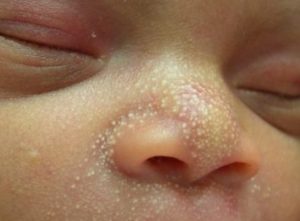
If you see white bumpy spots on the nose or face of your skin with a little bumpy structure, it is Milia or blocked oil glands. The oil glands in the face of a baby get blocked, which blocks a skin protein inside and develops this type of rash. It is harmless and will go away on its own. You can wash the face of your baby regularly to keep this rash from happening, and if it does happen, there is no need to be worried as it will clear on its own.
Scabies in Babies: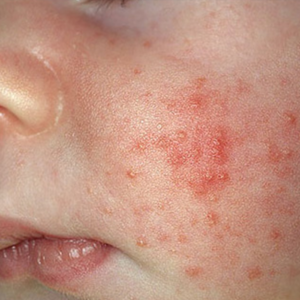
Scabies is a highly contagious skin rash that affects anyone; i.e., it affects adults and babies the same. In most cases, babies get this from a family member. Scabies are caused by mites that infest within the skin.
Scabies is treated by using creams that kill those mites. For the treatment to be effective, all the family members should get the treatment at the same time. To avoid getting scabies, always wash your hands with a disinfectant soap and keep your baby clean as well. Remember, a baby’s skin is susceptible, and it should be protected from all kinds of germs.
Slapped cheek syndrome: 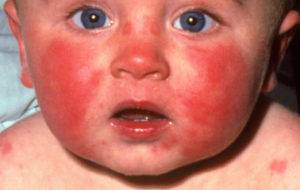
It is a viral skin condition. In this condition, the cheeks of the baby become red as if, sorry to say that, someone has been slapped. This condition mostly occurs after fever. You should expect a fever of about 100 F; sometimes, a sore throat is also associated with this kind of rash. An upset stomach is also a common occurrence.
Slapped Cheek Syndrome clears up on itself. Please give your baby lots of fluids in this condition and avoid sudden changes in the temperature of the surroundings. It can happen to anybody of any age. The good thing about this rash is that if you have it once, it will never happen to you again.
Eczema in Babies: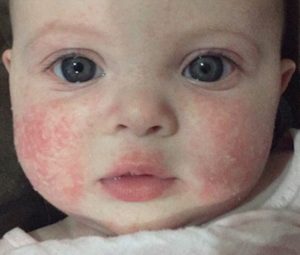
If your baby’s rash is causing the skin to become dry, red, itchy and cracked, she might have Eczema. Eczema is babies is mostly caused by an allergy to food, milk, and eggs especially. It often occurs on the inside and covered areas of the body like the inside of elbows, inside of knees and scalp in babies.
For Eczema, you may have to see your baby’s pediatrician, especially if it becomes itchier or if eczema is near the eyes or if your baby has asthma or some other known allergies. Be on the lookout for any specific diet that may be causing eczema. Like all other rashes, to avoid Eczema, use only baby soap and baby shampoo because using anything other than meant for the baby is going to cause dryness and possibly Eczema.
